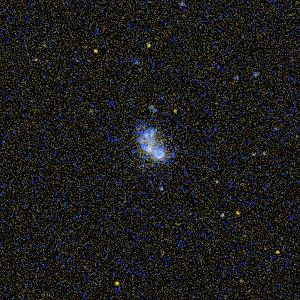GR 8 (galaxy) facts for kids
Quick facts for kids GR 8 |
|
|---|---|

GR8 (Gibson Reaves 8), galaxy in Virgo
|
|
| Observation data (J2000 epoch) | |
| Constellation | Virgo |
| Right ascension | 12h 58m 40.4s |
| Declination | ±14° 13′ 03″ |
| Type | ImV, dwarf galaxy |
| Apparent magnitude (V) | 14.7 |
| Notable features | With a lot of gas and one of the nearest galaxies to the Milky Way |
| Other designations | |
| Gibson Reaves 8, PGC 44491, UGC 8091, DDO 155, GR8 | |
| See also: Galaxy, List of galaxies | |
GR 8, also known as UGC 8091, is a small galaxy called a dwarf galaxy. It has lots of gas, which is important for making new stars. Scientists have measured its distance from Earth to be about 7.9 million light years away. A light-year is how far light travels in one year, which is a very long distance!
Even though GR 8 is quite close to our own galaxy, the Milky Way, scientists are still trying to figure out if it's part of our local group of galaxies. This group is called the Local Group.
Contents
What is GR 8?
GR 8 is a type of galaxy known as an irregular dwarf galaxy. This means it doesn't have a clear spiral or oval shape like many other galaxies. Instead, it looks a bit messy.
A Gas-Rich Galaxy
GR 8 is special because it has a lot of gas. This gas is mostly hydrogen and helium. These gases are the main ingredients for forming new stars. Because GR 8 has so much gas, it's a great place for astronomers to study how stars are born in smaller galaxies.
How Far Away is GR 8?
The distance to GR 8 is about 7.9 million light-years. To give you an idea, one light-year is about 9.46 trillion kilometers (or 5.88 trillion miles). So, 7.9 million light-years is an incredibly vast distance! This means the light we see from GR 8 today actually left the galaxy 7.9 million years ago.
Where is GR 8 Located?
GR 8 is found in the direction of the Virgo constellation. Virgo is a large constellation that you can see in the night sky. It's known for having many galaxies.
Is GR 8 Part of Our Local Group?
Our Milky Way galaxy is part of a collection of galaxies called the Local Group. This group includes other big galaxies like the Andromeda Galaxy and many smaller dwarf galaxies. Scientists are still studying GR 8 to see if it's gravitationally connected to the Local Group or if it's just a nearby galaxy that isn't part of our immediate neighborhood.
Related Pages
See also
 In Spanish: GR 8 para niños
In Spanish: GR 8 para niños

